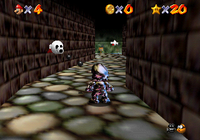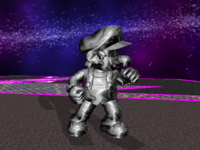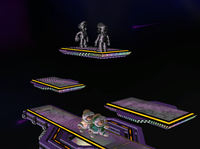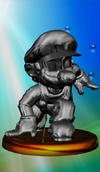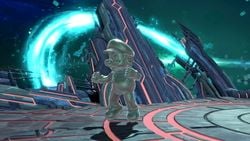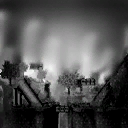Metal Mario: Difference between revisions
| Line 45: | Line 45: | ||
Metal Mario can be joined by a metallic form of [[Luigi]], known generally as '''Metal Luigi'''. Metal Luigi joins Metal Mario once {{SSBM|Luigi}} is unlocked, making the battle more difficult. Like Metal Mario, Metal Luigi is considered Luigi under the permanent effect of the [[Metal Box]]. Beating both characters will award the player with the "Metal Bros. KO" [[List of bonuses|bonus]]. | Metal Mario can be joined by a metallic form of [[Luigi]], known generally as '''Metal Luigi'''. Metal Luigi joins Metal Mario once {{SSBM|Luigi}} is unlocked, making the battle more difficult. Like Metal Mario, Metal Luigi is considered Luigi under the permanent effect of the [[Metal Box]]. Beating both characters will award the player with the "Metal Bros. KO" [[List of bonuses|bonus]]. | ||
In addition to their appearance in Adventure Mode, there is a chance that Metal Mario or Metal Luigi can appear as a random metal opponent on the penultimate stage in {{SSBM|Classic Mode}}, as it pits the player against a random metal character. | In addition to their appearance in Adventure Mode, there is a chance that Metal Mario or Metal Luigi can appear as a random metal opponent on the penultimate stage in {{SSBM|Classic Mode}}, as it pits the player against a random metal character. However, they are fought alone unlike in Adventure. Also if the player does Classic with {{SSBM|Mario}} or {{SSBM|Luigi}}, Mario or Luigi get excluded from inclusion as a metal opponent (as the selected character gets excluded from inclusion as an opponent). | ||
{{clrl}} | {{clrl}} | ||
Revision as of 14:29, October 3, 2021
| Metal Mario | |
|---|---|
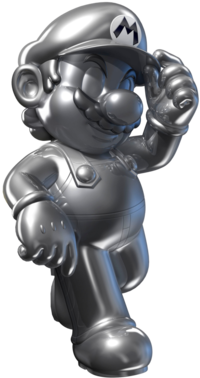  Official artwork of Metal Mario from Mario Kart 7. | |
| A boss in | SSB Melee Ultimate |
| Universe | Mario |
| Console of origin | Nintendo 64 |
| Location | Meta Crystal Battlefield New Donk City Hall (Ω form) |
| Article on Super Mario Wiki | Metal Mario |
Metal Mario (メタルマリオ, Metal Mario) is a character in the Mario series.
Origin
Metal Mario originated in Super Mario 64 as a powered-up form of Mario, alongside Wing Mario and Vanish Mario. Mario can become Metal Mario by collecting a Metal Cap, but must first press the Green Switch in a cavern hidden in Hazy Maze Cave. After Super Mario 64, Metal Mario was given a character and personality, becoming entirely separate from the powered-up form of Mario. Since then, Metal Mario has made several recurring appearances as a playable character, including Mario Golf, Dr. Mario 64, and the Mario Kart series.
Unlike Metal Mario, Metal Luigi as a standalone character is original to the Super Smash Bros. series.
In Super Smash Bros.
As a minor boss
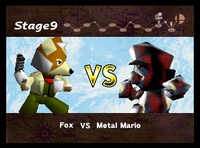
Metal Mario appears in the 1P Game mode of this game as a minor boss opponent to be battled one-on-one. Despite appearing at first glance to be just a simple palette-swap of Mario, he is a very different fighter; he barely flinches to ordinary attacks and is almost unaffected by throws at low percentages, and can sustain an absurd amount of damage before even being put into KO range (often over 300%). However, he is very weak to edge-guarding: once a player manages to knock him off the stage, he will often fail to recover due to his extremely fast falling speed, despite the decent distance that Super Jump Punch grants. Metal Mario never sprints and rarely jumps; he simply walks from place to place at a steady pace. Metal Mario also seldom uses his Fireball even though a normal CPU Mario uses it often, and Kirby will not gain a copy ability from inhaling him. On lower difficulties he mainly walks around the stage, seldom attacking, but he can be tougher on higher difficulties. The stage Metal Mario is fought on cannot be selected through normal means.
As a playable character
Metal Mario can be controlled using certain cheat codes such as the debug menu. However, many players consider Metal Mario to be far worse than normal Mario; despite his aforementioned strengths in resisting knockback, he's less resistant to it than his story mode counterpart, has reduced combo potential, as he cannot efficiently follow up with combos after attacking due to an abysmal short hop, and has awkward aerial and dashing physics. As mentioned before, he also has an extremely quick falling speed, which not only hinders his recovery, but makes him very vulnerable to chaingrabs and certain combos.
In Super Smash Bros. Melee
As a minor boss
Metal Mario more or less reprises his role as a minor boss opponent in the single-player Adventure Mode. He appears on the Battlefield stage after the player defeats the fifteen Fighting Wire Frames. Unlike the previous game, Metal Mario is not considered by the game to be a separate character, but rather regular Mario permanently under the effects of the new Metal Box item and with slightly faster falling speed than usual. He also does not resist knockback as much as in the original game.
Metal Mario can be joined by a metallic form of Luigi, known generally as Metal Luigi. Metal Luigi joins Metal Mario once Luigi is unlocked, making the battle more difficult. Like Metal Mario, Metal Luigi is considered Luigi under the permanent effect of the Metal Box. Beating both characters will award the player with the "Metal Bros. KO" bonus.
In addition to their appearance in Adventure Mode, there is a chance that Metal Mario or Metal Luigi can appear as a random metal opponent on the penultimate stage in Classic Mode, as it pits the player against a random metal character. However, they are fought alone unlike in Adventure. Also if the player does Classic with Mario or Luigi, Mario or Luigi get excluded from inclusion as a metal opponent (as the selected character gets excluded from inclusion as an opponent).
As a trophy
Metal Mario also appears as a trophy which can be acquired randomly through the 1-P mode or the Trophy lottery:
- Metal Mario
- Mario was in for a surprise the first time he hit a Metal Box in Super Mario 64. The metal cap that popped out transformed Mario into living metal, giving him great stamina, a heavy tread, and the ability to walk underwater. In Super Smash Bros., Metal Mario showed up as an incredibly stubborn midlevel boss.
- Super Mario 64
9/96
- Super Mario 64
In Super Smash Bros. Brawl and Super Smash Bros. 4
In both Brawl and Smash 4, Metal Mario and Metal Luigi are no longer specific characters, and instead can merely appear as a potential metal opponent fought in Classic Mode. They are randomly fought on Stage 8. Like in Melee's Classic Mode, they are once again randomly fought alone. Metal opponents are fought randomly on Stages 6, 7, 8, 9, or 10. So Metal Mario and Metal Luigi --like all metal characters-- are not fought in Battlefield (unlike on 1 player modes from the previous two installments). Additionally Peach and Bowser also can be a metal opponent in addition to Metal Mario or Metal Luigi. All metal characters (depending with the universe) are fought on their home stages rather than Battlefield.
In Super Smash Bros. for Wii U, a metal version of Mario or Luigi can appear as an intruder just as any other opponent can, replacing one of the opponents before a battle. They can also be fought in Crazy Orders, where they can appear on any random stage (not limited to Super Smash Bros. or Mario stages).
Metal versions of Mario and Luigi outside of Classic Mode in Brawl and SSB4 can once again be played as by collecting a Metal Box, and can additionally appear through a modifier for Special Smash.
In Super Smash Bros. Ultimate
Metal Mario returns as a boss character in Ultimate. He is fought after defeating regular Mario during the final stage of Bowser's Classic Mode.
Metal Mario also appears as a spirit. His spirit battle pits the player against a metal version of Mario on The Great Cave Offensive's Battlefield form. This stage's background features crystals similar to those found in the background of Meta Crystal during the Metal Mario fight in Smash 64, while the music (Metal Battle from Melee) and the Battlefield layout are reminiscent of the Metal Mario fight in Melee.
Metal versions of Mario and Luigi can once again be played as by collecting a Metal Box or by playing in Metal Smash.
Spirit
| No. | Image | Name | Type | Class | Slots | Base |
Max |
Base |
Max |
Base |
Max |
Ability | Series |
|---|---|---|---|---|---|---|---|---|---|---|---|---|---|
| 21 | Metal Mario | ★★★ | 1 | 2705 | 8156 | 510 | 1539 | 2042 | 6156 | Weight ↑ | Super Mario Series |
Names in other languages
Trivia
- If one looks closely at the reflection on Metal Mario's trophy in Melee, the Yoshi's Island stage can be seen. This is easiest to spot on his hat, nose, or bottom.
- Metal Mario along with Giant Donkey Kong and to a degree Master Hand (from the Master Hand Glitch) are the first characters to be non-playable in one game, then playable in all future games (with items and/or Special Modes). They would be followed by Giga Bowser.
- In Super Smash Bros., Metal Mario's series symbol is a bit different from the Mario series, making it more metallic.
- In Smash 64's 1P Game, when the Announcer introduces Metal Mario, his voice gains a slight change and becomes metallic. Although it may just be to place emphasis on Mario's metal composition, the Announcer's voice sounds noticeably deeper and the same change in voice does not occur for announcing any other character in Classic Mode.
